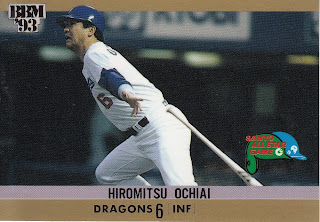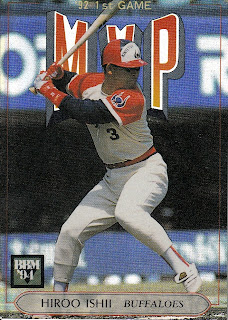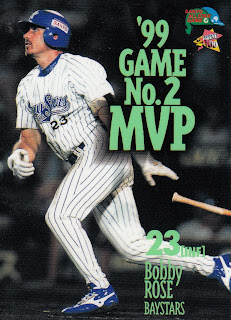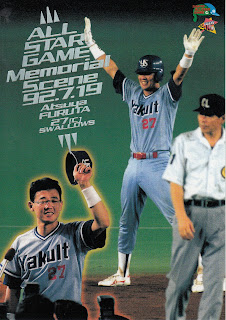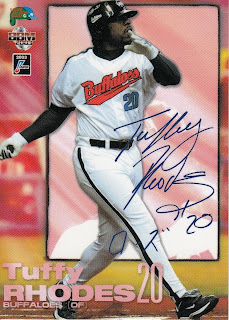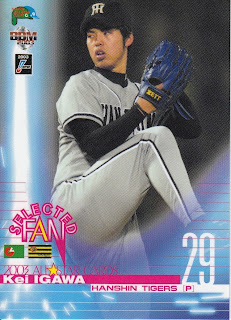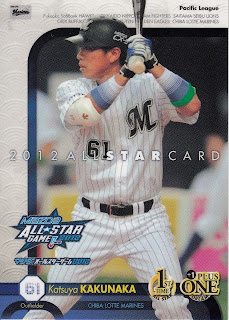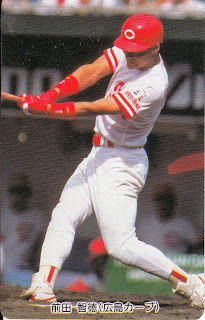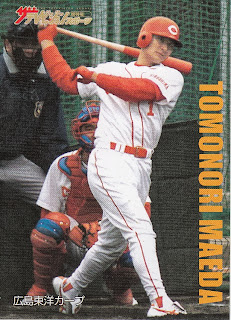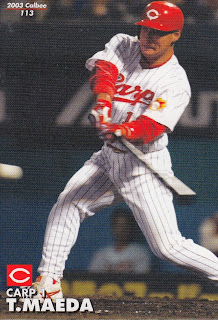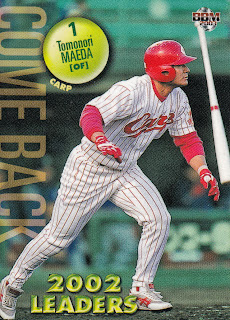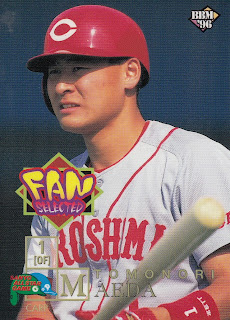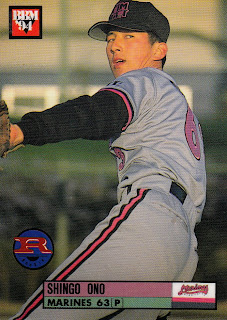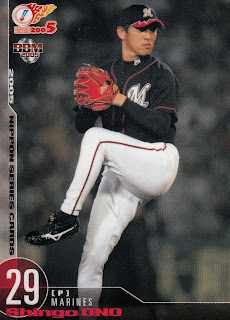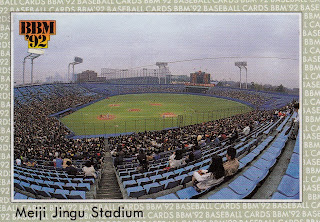It's looking more and more like BBM has decided to discontinue the annual All Star box set. BBM had produced this box set featuring all the players who had made the All Star teams each year they produced cards, starting in 1991.
That first set in 1991 included 62 cards - for each of the two leagues' teams there were 28 cards for the players, a card for the manager (as in MLB the manager is the manager from the previous year's Nippon Series team) and 2 cards for the coaches for the team (two other managers from the league - so half the managers in NBP appear in each set). This established the pattern for the base cards that would continue for the rest of sets - the only things that would change were the number of player cards (since the number of players on the teams would rise and fall) and additional subsets, inserts and parallels would be added.
The 1991 set also established a pattern that would last 10 year - the card design of the base cards would closely resemble that of the "flagship" set for that year. There was one thing though that BBM did with the 1991 set that they never did again - they numbered the set as a continuation of the "flagship" set, starting with number 401.
![]() |
| 91 BBM All Stars #404 |
The 1992 set would grow to 66 cards as apparently the number of players on each team went to 30 that year. The Central League player cards had a gold border while the Pacific League cards had a silver border.
![]() |
| 1992 BBM All Star #A49 |
In 1993, the team size dropped back to 28 although for some reason - probably an injury to someone - the Central League team had 29 players, so the set had 63 cards. As in 1992, the CL cards had gold borders and the PL had silver.
![]() |
| 1993 BBM All Stars #A28 |
BBM decided to try to punch things up a little in 1994. Each box contained two of six possible "All Star Electric MVP" insert cards. The cards included the six players who had been named MVP of the All Star games from 1991 to 1993 (there were actually seven games but Atsuya Furuta was the MVP of two of them). In addition, BBM added a big graphic on the card indicating that the player was selected to the team via the fan vote - previously there had just been a small line of text on the card. I believe that this 64 card set (62 regular cards plus 2 inserts) contains the first card where Ichiro Suzuki is only referred to by his first name.
![]() |
| 1994 BBM All Stars #A42 |
![]() |
| 1994 BBM All Stars Insert #E3 |
The 1995 set also included inserts but this time each box only contained one of two possible cards (in addition to the 62 regular cards). The inserts were the MVPs from the two All Star games in 1994.
![]() |
| 1995 BBM All Stars #A14 |
![]() |
| 1995 BBM All Stars Insert #E1 |
Some more changes were in store for the 1996 set. Instead of insert cards, BBM included two cards showing the award winners (including the MVP) for each of the 1995 All Star games. In addition the set also included an oversized (2.5 inch by 4.74 inch) card of Ichiro in honor of him getting the most votes overall). With the addition of these cards and each team growing to 30 players again, the set grew to 69 cards.
![]() |
| 1996 BBM All Stars #A37 |
![]() |
| 1996 BBM All Stars #A68 |
![]() |
| 1996 BBM All Stars #A69 |
The 1997 set was very similar to the 1996 set. The subset for the previous year's All Star game award winners was included again, although since there were three games in 1996 there were three cards in the subset. There was an oversized card (same size as the year before) of Hideki Matsui included labelled "Monster Season" - it's not for getting the most votes as the back of the card shows that Matsui got the fourth most votes - Ichiro got the most again. Since the team sizes dropped to 28 again, the set actually shrunk a card to 66 cards.
![]() |
| 1997 BBM All Stars #A41 |
![]() |
| 1997 BBM All Stars #A63 |
![]() |
| 1997 BBM All Stars #A66 |
For the 1998 set BBM decided that one oversized card was not enough, so they included three in the set - two for the 1997 All Star MVPs (Kazuo Matsui and Kazuhiro Kiyohara) and one for Kazuhiro Sasaki (like the Hideki Matsui card in 1997, this was not for being the top vote getter). The oversized cards increased to post card size (3.5 by 5 inches). Despite the big MVP cards, the set still contains the group Award Winner subset. With the teams remaining at 28 players, the set contained 67 cards in all.
![]() |
| 1998 BBM All Stars #A15 |
![]() |
| 1998 BBM All Stars #A66 |
The 1999 set is a little busier than the earlier sets. The teams went back to 30 players so there were 66 "regular" cards of players, coaches and managers. The 1998 All Star MVPs (Kenshin Kawakami and Hideki Matsui) were commemorated with the postcard sized cards again. But the group Award cards were not included (and really wouldn't be included ever again). Instead BBM included a card of Daisuke Matsuzaka labelled "Super Rookie". There was a parallel version of this card included in roughly a quarter of the boxes - I'm not sure what the nature of the "parallel" was (gold text? kira?). There was also a card included in the set that commemorated Yutaka Enatsu's performance in one of the 1971 All Star games (nine consecutive strikeouts in a game that the CL nohit the PL - he also homered in the game) - no idea why this card was included in the set unless it was some sort of "best All Star game moment of the 20th Century" thing. The set reached a total of 70 cards for the first time.
![]() |
| 1999 BBM All Stars #A11 |
![]() |
| 1999 BBM All Stars #A69 |
![]() |
| 1999 BBM All Stars #A67 |
For the tenth All Star set in 2000, BBM released a set that pretty much set the pattern for the remainder of the sets. In addition to the 66 "regular" cards (the teams remained at 30 players), there were three cards (regular sized) for the MVPs of the 1999 All Star games along with a single card (also regular sized) for the top vote getter (Ichiro again). The set did included two more oversized cards for "All Star Game Memorial Scenes" - two top scenes from the previous 10 years. One of these was Ichiro pitching in one of the 1996 games (he was supposed to pitch to Hideki Matsui but since Katsuya Nomura has no sense of humor, he ended up pitching to Shingo Takatsu instead). The other was for Atsuya Furuta becoming the first player to ever hit for the cycle in an All Star game in 1992. The set ended up containing 72 cards.
![]() |
| 2000 BBM All Stars #A43 |
![]() |
| 2000 BBM All Stars #A69 |
![]() |
| 2000 BBM All Stars #A71 |
I'll cover the rest of the sets in another post in the next few days.


